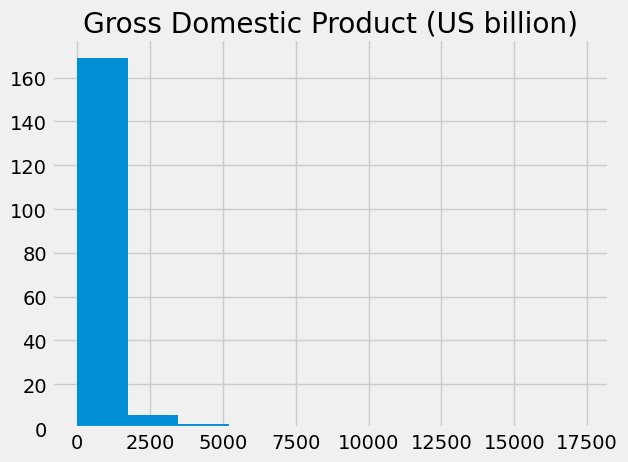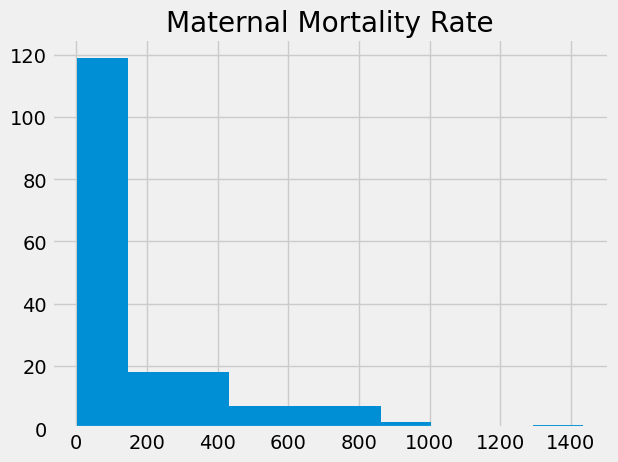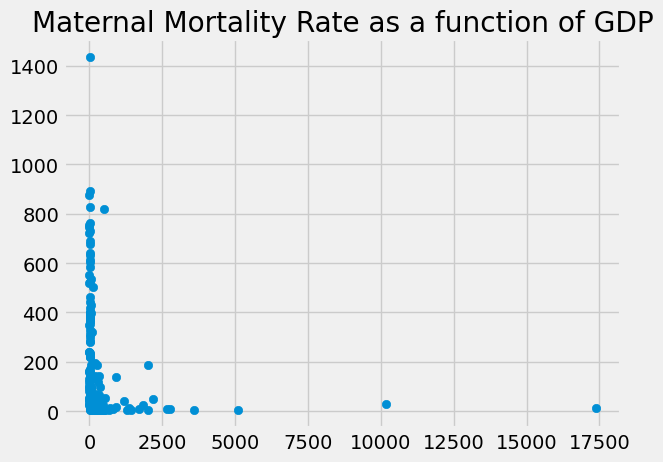Selecting columns from DataFrames#
# Load the Pandas data science library, call it 'pd'
import pandas as pd
# Turn on a setting to use Pandas more safely.
# We will discuss this setting later.
pd.set_option('mode.copy_on_write', True)
# Load the library for plotting, name it 'plt'
import matplotlib.pyplot as plt
# Make plots look a little more fancy
plt.style.use('fivethirtyeight')
Let us return to the DataFrame we had at the end of the previous notebook The data frame index.
# Original data frame before dropping missing values.
gender_data = pd.read_csv('gender_stats_min.csv')
gender_data_no_na = gender_data.dropna()
labeled_gdata = gender_data_no_na.set_index('country_code')
# Show the result
labeled_gdata
| country_name | gdp_us_billion | mat_mort_ratio | population | |
|---|---|---|---|---|
| country_code | ||||
| AFG | Afghanistan | 19.961015 | 444.00 | 32.715838 |
| AGO | Angola | 111.936542 | 501.25 | 26.937545 |
| ALB | Albania | 12.327586 | 29.25 | 2.888280 |
| ARE | United Arab Emirates | 375.027082 | 6.00 | 9.080299 |
| ARG | Argentina | 550.980968 | 53.75 | 42.976675 |
| ... | ... | ... | ... | ... |
| WSM | Samoa | 0.799887 | 54.75 | 0.192225 |
| YEM | Yemen, Rep. | 36.819337 | 399.75 | 26.246608 |
| ZAF | South Africa | 345.209888 | 143.75 | 54.177209 |
| ZMB | Zambia | 24.280990 | 233.75 | 15.633220 |
| ZWE | Zimbabwe | 15.495514 | 398.00 | 15.420964 |
179 rows × 4 columns
Selecting columns#
You have seen array indexing (in Selecting with arrays. You remember that array indexing uses square brackets. Indexing is the technical term for getting data from a value using square brackets. Data frames also allow indexing. For example, we often want to get all the data for a single column of the data frame. To do this, we use the same square bracket notation as we use for array indexing, with the name of the column inside the square brackets.
gdp = labeled_gdata['gdp_us_billion']
Call this column label indexing.
We all also call this direct indexing with column labels or DICL.
By direct indexing we mean indexing a DataFrame using square brackets after the DataFrame value — the kind of indexing you will be familiar with from arrays. Later we will come across another form of indexing, called indirect indexing, but that is for another time.
What type of value came back from this direct indexing with column labels?
type(gdp)
pandas.core.series.Series
Pandas sent back a Series value from our selection of the column. The Series
is a Pandas’ way of representing a column of data. Here is the default display
for the gdp Series:
gdp
country_code
AFG 19.961015
AGO 111.936542
ALB 12.327586
ARE 375.027082
ARG 550.980968
...
WSM 0.799887
YEM 36.819337
ZAF 345.209888
ZMB 24.280990
ZWE 15.495514
Name: gdp_us_billion, Length: 179, dtype: float64
The display shows the values from the column, that you saw previously in the
DataFrame gdp_us_billion column. You see the values printed on the right.
Notice too that the Series has kept the row labels from the DataFrame, so
each value now has it’s corresponding row label. The index values are on the
left.
Notice that, if your string specifying the column name does not match a column name exactly, you will get a long error. This gives you some practice in reading long error messages - skip to the end first, you will often see the most helpful information there.
# The correct column name is in lower case.
labeled_gdata['GDP_US_BILLION']
---------------------------------------------------------------------------
KeyError Traceback (most recent call last)
File /opt/hostedtoolcache/Python/3.11.9/x64/lib/python3.11/site-packages/pandas/core/indexes/base.py:3805, in Index.get_loc(self, key)
3804 try:
-> 3805 return self._engine.get_loc(casted_key)
3806 except KeyError as err:
File index.pyx:167, in pandas._libs.index.IndexEngine.get_loc()
File index.pyx:196, in pandas._libs.index.IndexEngine.get_loc()
File pandas/_libs/hashtable_class_helper.pxi:7081, in pandas._libs.hashtable.PyObjectHashTable.get_item()
File pandas/_libs/hashtable_class_helper.pxi:7089, in pandas._libs.hashtable.PyObjectHashTable.get_item()
KeyError: 'GDP_US_BILLION'
The above exception was the direct cause of the following exception:
KeyError Traceback (most recent call last)
Cell In[6], line 2
1 # The correct column name is in lower case.
----> 2 labeled_gdata['GDP_US_BILLION']
File /opt/hostedtoolcache/Python/3.11.9/x64/lib/python3.11/site-packages/pandas/core/frame.py:4102, in DataFrame.__getitem__(self, key)
4100 if self.columns.nlevels > 1:
4101 return self._getitem_multilevel(key)
-> 4102 indexer = self.columns.get_loc(key)
4103 if is_integer(indexer):
4104 indexer = [indexer]
File /opt/hostedtoolcache/Python/3.11.9/x64/lib/python3.11/site-packages/pandas/core/indexes/base.py:3812, in Index.get_loc(self, key)
3807 if isinstance(casted_key, slice) or (
3808 isinstance(casted_key, abc.Iterable)
3809 and any(isinstance(x, slice) for x in casted_key)
3810 ):
3811 raise InvalidIndexError(key)
-> 3812 raise KeyError(key) from err
3813 except TypeError:
3814 # If we have a listlike key, _check_indexing_error will raise
3815 # InvalidIndexError. Otherwise we fall through and re-raise
3816 # the TypeError.
3817 self._check_indexing_error(key)
KeyError: 'GDP_US_BILLION'
GDP and Maternal Mortality Rate#
There are two ways of getting plots from data in data frames. Here we use the most basic method, that you have already seen. Soon, we will get onto a more elegant plotting method.
The gdp variable is a sequence of values, so we can do a histogram on these
values, as we have done histograms on arrays.
plt.hist(gdp)
plt.title('Gross Domestic Product (US billion)');

Now we have had a look at the GDP values, we will look at the values for the
Maternal Mortality Rate (MMR). The MMR is the number of women who die in
childbirth for every 100,000 births. These are the numbers in the
mat_mort_ratio column.
mmr = labeled_gdata['mat_mort_ratio']
mmr
country_code
AFG 444.00
AGO 501.25
ALB 29.25
ARE 6.00
ARG 53.75
...
WSM 54.75
YEM 399.75
ZAF 143.75
ZMB 233.75
ZWE 398.00
Name: mat_mort_ratio, Length: 179, dtype: float64
Notice the row labels on the left, and the values from the mat_mort_ratio
column on the right.
plt.hist(mmr)
plt.title('Maternal Mortality Rate');

Selecting more than one column#
Let us say that we would like to avoid distraction by restricting our data frame to the columns we are interested in.
There are our columns labels:
col_labels = list(labeled_gdata)
col_labels
['country_name', 'gdp_us_billion', 'mat_mort_ratio', 'population']
Let us say that, for now, we only want the first three columns. We can do that with direct indexing with column labels (DICL) too. To do that, we put a list of strings between the square brackets, instead of the string with the column name.
Here are the column labels we want:
# Select all labels but the last.
col_labels_we_want = col_labels[:-1]
col_labels_we_want
['country_name', 'gdp_us_billion', 'mat_mort_ratio']
We can select only these columns using direct indexing:
# Direct indexing with a list of column labels
thinner_gdata = labeled_gdata[col_labels_we_want]
thinner_gdata
| country_name | gdp_us_billion | mat_mort_ratio | |
|---|---|---|---|
| country_code | |||
| AFG | Afghanistan | 19.961015 | 444.00 |
| AGO | Angola | 111.936542 | 501.25 |
| ALB | Albania | 12.327586 | 29.25 |
| ARE | United Arab Emirates | 375.027082 | 6.00 |
| ARG | Argentina | 550.980968 | 53.75 |
| ... | ... | ... | ... |
| WSM | Samoa | 0.799887 | 54.75 |
| YEM | Yemen, Rep. | 36.819337 | 399.75 |
| ZAF | South Africa | 345.209888 | 143.75 |
| ZMB | Zambia | 24.280990 | 233.75 |
| ZWE | Zimbabwe | 15.495514 | 398.00 |
179 rows × 3 columns
Dropping columns#
We have just used DICL to select the columns we want. In the case above, we selected three out of the four column labels, and our DICL operation had the effect of dropping the last column.
Another way of dropping a column is to use the DataFrame .drop method.
In fact the .drop method allows us to drop columns and rows. To tell .drop we want to drop columns rather than rows, we use the column= keyword argument to .drop, like this:
# Drop the population column.
thinner_again = labeled_gdata.drop(columns=['population'])
thinner_again
| country_name | gdp_us_billion | mat_mort_ratio | |
|---|---|---|---|
| country_code | |||
| AFG | Afghanistan | 19.961015 | 444.00 |
| AGO | Angola | 111.936542 | 501.25 |
| ALB | Albania | 12.327586 | 29.25 |
| ARE | United Arab Emirates | 375.027082 | 6.00 |
| ARG | Argentina | 550.980968 | 53.75 |
| ... | ... | ... | ... |
| WSM | Samoa | 0.799887 | 54.75 |
| YEM | Yemen, Rep. | 36.819337 | 399.75 |
| ZAF | South Africa | 345.209888 | 143.75 |
| ZMB | Zambia | 24.280990 | 233.75 |
| ZWE | Zimbabwe | 15.495514 | 398.00 |
179 rows × 3 columns
Back to GDP and MMR#
We are interested in the relationship of gpp and mmr. Maybe richer
countries have better health care, and fewer maternal deaths.
Here is a plot, using the standard Matplotlib scatter
function.
plt.scatter(gdp, mmr);
plt.title('Maternal Mortality Rate as a function of GDP');

The scatterplot is not convincing in showing a relationship between GDP and the MMR. That is puzzling, given the assumption that higher GDP tends to be associated with better healthcare.
We need to explore some more. For example, could it be that, beyond a certain level of GDP, healthcare is good enough to prevent most maternal deaths? In that case, we might still expect a relationship between GDP and MMR in lower-income countries, but a much weaker relationship for lower-income countries.
To go further, we will see what we can do by sorting the DataFrame, and looking at the first and last rows.


